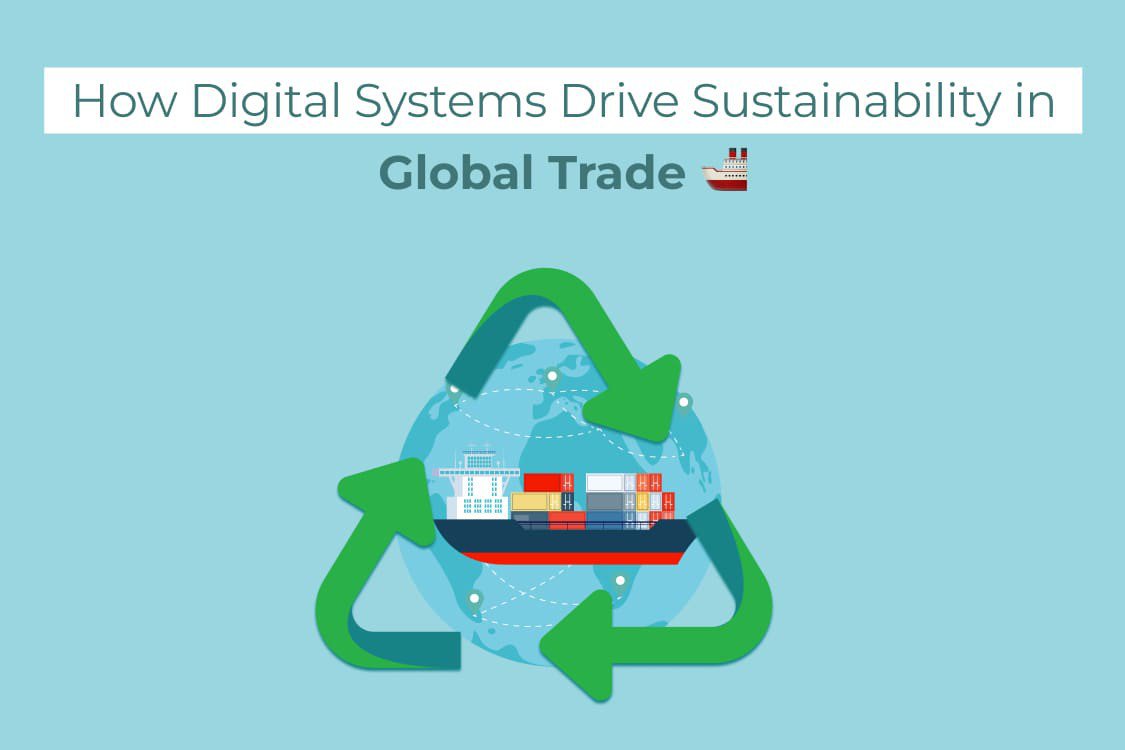
Global trade is the backbone of the world economy, but its environmental impact cannot be ignored. From excessive paperwork to carbon emissions, traditional trade practices contribute significantly to ecological challenges. Digital transformation is revolutionizing the industry by enhancing efficiency and reducing its environmental footprint. By adopting paperless trade, automation, and smart logistics, businesses can align with global sustainability goals while optimizing operations. This article explores how digital systems are shaping a more sustainable future for global trade.
The Environmental Impact of Traditional Trade Practices
For decades, global trade has relied on paper-heavy documentation and resource-intensive processes. Bills of lading, customs declarations, invoices, and certificates require millions of pages annually, contributing to deforestation and waste. Additionally, manual handling of shipments, inefficient route planning, and outdated tracking mechanisms lead to higher fuel consumption and increased carbon emissions. These inefficiencies highlight the urgent need for digital solutions to drive sustainability in trade.
Paperless Trade: Reducing Waste and Improving Efficiency
Paperless trade is one of the most significant advancements toward sustainable global trade. By digitizing documentation and automating workflows, businesses can reduce paper waste and streamline operations. Digital platforms facilitate seamless communication between stakeholders, ensuring faster processing and minimizing errors.
Key benefits of paperless trade:
- Reduced Carbon Footprint: Eliminating physical paperwork decreases paper consumption, printing, and transportation needs.
- Faster Transactions: Digital documentation allows for quicker approvals, reducing delays and improving supply chain efficiency.
- Enhanced Transparency: Electronic records provide better traceability and minimize fraud risks.
- Cost Savings: Companies save on printing, storage, and courier costs while improving overall efficiency.
Smart Logistics and Sustainable Shipping
Modern digital logistics systems optimize shipping routes, reducing fuel consumption and emissions. Technologies like AI help improve decision-making and supply chain visibility.
Some of the key digital interventions in sustainable shipping include:
- AI-Powered Route Optimization: AI analyzes traffic, weather, and demand patterns to determine the most efficient shipping routes, cutting fuel usage and emissions.
- Real-Time Tracking and Visibility: IoT-enabled sensors provide real-time data on cargo conditions, helping reduce wastage and improve resource utilization.
- Predictive Analytics for Demand Planning: Data-driven insights allow businesses to prevent overproduction and unnecessary shipping, reducing waste.
Green Freight and Digital Marketplaces
Freight transportation accounts for a significant portion of global carbon emissions. Digital freight marketplaces, such as FreightMango, promote sustainable shipping by enabling businesses to compare rates, select eco-friendly carriers, and optimize container utilization.
How FreightMango contributes to sustainability:
- Consolidation of Shipments: Reduces empty container movements, improving efficiency and lowering emissions.
- Eco-Friendly Carrier Selection: Allows businesses to choose carriers with lower carbon footprints.
- Data-Driven Insights: Provides recommendations for greener shipping options based on real-time analytics.
The Role of Automation and AI in Sustainable Trade
Automation in trade reduces manual intervention, enhancing speed and accuracy. AI-driven systems optimize supply chain processes, reducing unnecessary resource consumption.
Key contributions of automation and AI:
- Digital Customs Clearance: Automated customs declarations streamline trade compliance, minimizing delays and reducing paperwork.
- Smart Warehousing: AI-driven inventory management reduces waste by optimizing stock levels and storage conditions.
- Energy-Efficient Operations: AI-controlled systems help minimize energy usage in warehouses and transportation hubs.
Challenges in Adopting Digital Systems for Sustainability
Despite the evident benefits, the adoption of digital systems in trade comes with challenges:
- Initial Investment Costs: Transitioning to digital infrastructure requires upfront investments in technology and training.
- Cybersecurity Concerns: Digital systems are susceptible to cyber threats, requiring robust security measures.
- Regulatory Compliance: Different countries have varying regulations regarding digital trade, requiring alignment and standardization.
- Resistance to Change: Some businesses hesitate to shift from traditional methods due to unfamiliarity with digital tools.
Conclusion
Digital transformation in global trade is essential for driving sustainability. By adopting paperless trade, AI-powered logistics, and smart shipping solutions, businesses can significantly reduce their environmental footprint while improving efficiency and cost-effectiveness. FreightMango enables businesses to embrace digital trade seamlessly, promoting greener and smarter shipping solutions. As the industry evolves, digitalization will play a crucial role in achieving long-term sustainability goals, ensuring a balance between economic growth and environmental responsibility.





 Get instant quote
and compare offers in real time
Get instant quote
and compare offers in real time